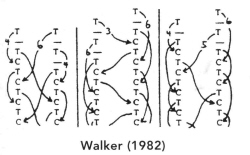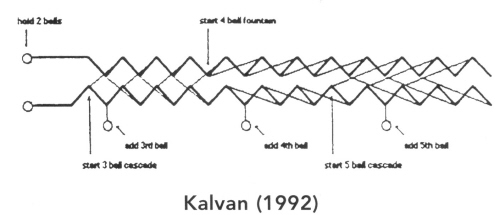 |
 |
Page 35 Winter 1993-94
|
The
diagram also appeared in Peter Jan Beek's 1989 Ph.D. thesis from
Vrije Universiteit in Amsterdam, "Juggling Dynamics."
Beek calls the diagram a "tonality ladder," and says
he heard about it from Charlie Dancey, a former partner of the
noted U.K. juggler Haggis. The diagram also shows up in Kaskade
number 25, March 1992, in ''Juggling on Paper" by Joachim
Voigt, pp. 16-17 (note this is the same title as Simpson's
article). Voigts version has an extension for marking the type
of throw in club juggling (e.g., number of spins). The diagram
reappears in Kaskade #29, in "Workshop - Juggling Theory,
part 1: The DAB Theorum (sic) and other serious illnesses"
March, 1993, pp. 35-37, by JOTA (Jongliertheoretische
Arbeitgemeinschaft). It is also mentioned (though not used) in
Martin Probert's 1990 book, "491 Patterns for the Solo
Juggler."
Another
variant of the diagram, designed to show the length of time that
hands spend full and empty, is in "Juggling Made
Complicated" by Jack Kalvan. Jack's unpublished paper has
many interesting results in it, including a calculation of the
maximum permitted errors to avoid collisions in standard
juggling patterns. Jack also worked on the now-defunct juggling
robot project at IBM, and is half of the noted juggling duo
Clockwork. (Although Jack and Rick Rubenstein didn't know it
when they named themselves Clockwork, the name is reminiscent of
how the Elgins, a
Vaudeville juggling group, were named. Elgin was the name of a
watch manufacturer at the time. The group walked by a jewelry
store that posted the ad, "Elgin: precision timing"
and decided that was a good name for a juggling troupe).
So,
did Simpson 1986 invent the diagram? No. Both Voigt and Probert
refer back to Jeff Walker. This is the 1982 article I skipped
over above. It is "Variations for Numbers
Jugglers," in the January 1982
issue of Juggler's World, page 11. This short article, less
than one page, not only has the juggling diagram, but uses it to
invent some site swap moves, contains the basic site swap idea of
having, for example, a 5 denote a five ball cascade throw, and
even has
So
Walker laid the groundwork for site swaps and MHN, but did he also
invent the diagram? Perhaps, but around 1981 Claude Shannon began
writing an article called, "Scientific Aspects of
Juggling." It was supposed to appear in Scientific American,
but he never finished it. After gathering dust for over a decade,
it was finally published a few months ago in the book:
"Claude Elwood Shannon Collected Papers," edited by
N.J.A. Sloane and A. D. Wyner, New York: IEEE press, pp. 850864.
The paper has no site swaps, but there in Figure 5 are three
juggling patterns, depicted using the same diagram.
Interestingly,
in every place the diagram appears except in Shannon's and
Kalvan's articles, the diagram is drawn vertically with the time
axis running from top to bottom. Only Claude and Jack followed the
Apparently,
something clicked in the 1980's, causing the site swap diagram and
notation to be independently rediscovered many times. In contrast,
the 1990's are fast becoming the decade where the theory goes into
practice, with jugglers everywhere learning how to perform site
swaps. Remember when a 3-3-10 was a club passing pattern and not
an illegal site swap for 5-1/3 balls?
"The
Academic Juggler" is an occasional feature of Jugglers
World, and is devoted to all kinds of formal
analyses of juggling. Anybody who has suggestions, comments, or
potential contributions for this feature is encouraged
to write to me, Arthur Lewbel, Lexington, MA. Please
include a phone number if |
 |
 |
 |